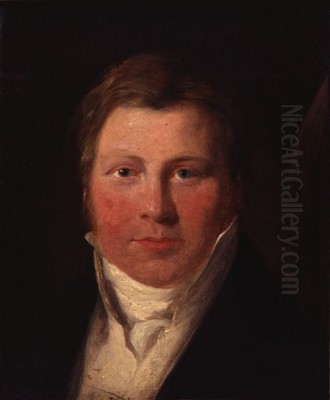
John Varley stands as a pivotal figure in the golden age of British watercolour painting. Born in London in 1778 and passing away in 1842, his life spanned a period of significant transformation in the art world. Varley was not only a prolific and highly skilled landscape painter but also one of the most influential art teachers of his generation. Furthermore, his interests extended beyond the canvas into the realms of astrology and invention, making him a fascinating and somewhat eccentric character whose impact resonated deeply within early 19th-century British culture. His dedication to the medium of watercolour, his systematic approach to teaching, and his unique personality secured his place in art history.
Early Life and Artistic Beginnings
John Varley was born in the district of Hackney, London, on August 17, 1778. His father, Richard Varley, held scientific interests but initially discouraged his son's artistic inclinations, perhaps due to the precarious nature of an artist's life. Following his father's death, the young Varley was briefly apprenticed to a silversmith. However, his passion for drawing soon led him towards a different path. He found early employment with an architectural draughtsman, Joseph Charles Barrow, who ran an evening drawing school. This experience provided Varley with foundational skills in precision and perspective, which would inform his later landscape work.
Barrow took Varley on a sketching tour to Peterborough, which proved formative. It was during this trip that Varley likely produced studies for one of his early acclaimed works. By 1798, at the age of twenty, Varley was accomplished enough to exhibit his first work at the prestigious Royal Academy. This marked the beginning of a long and productive career dedicated primarily to the art of landscape painting in watercolour. His early works showed promise, blending topographical accuracy with an emerging sensitivity to atmosphere and light.
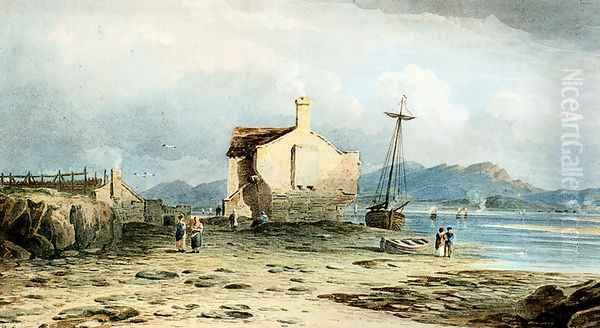
His artistic development was further nurtured by his association with Dr. Thomas Monro, a physician and art patron whose home served as an informal academy for young artists. There, Varley likely studied and copied works by earlier masters, honing his technique alongside contemporaries who would also become significant figures, such as the brilliant, short-lived Thomas Girtin and the burgeoning genius J.M.W. Turner. This environment provided invaluable exposure and fostered a spirit of artistic exploration.
The Rise of Watercolour and the SPWC
In the late 18th and early 19th centuries, watercolour painting was often considered secondary to oil painting, frequently relegated to preparatory sketches or topographical records. The Royal Academy offered limited exhibition space and recognition for watercolourists. John Varley played a crucial role in challenging this hierarchy and elevating the status of the medium. He was a driving force behind the establishment of the Society of Painters in Water-Colours (SPWC), often referred to as the Old Water-Colour Society, founded in 1804.
The SPWC provided a dedicated venue for watercolour artists to exhibit and sell their work, fostering a sense of community and professional identity. Varley was not just a founding member; he was a prolific contributor to its annual exhibitions for the rest of his life, showcasing hundreds of paintings. The Society's success helped to popularize watercolour painting among a broader public, moving it from the aristocratic portfolio into middle-class homes. Varley's commitment to the SPWC demonstrated his belief in the expressive potential and legitimacy of watercolour as a finished art form.
His involvement with the SPWC cemented his position as a leading figure in the London art scene. He actively participated in its affairs and championed the cause of his fellow watercolourists. The Society became a focal point for innovation and excellence in the medium, and Varley's consistent presence and high-quality work set a standard for others. His efforts contributed significantly to the recognition of watercolour as a distinctively British art form during this period.
Artistic Style and Techniques
John Varley's artistic style evolved throughout his career but is generally characterized by its breadth, simplicity, and serene, classical composure, often infused with a subtle romantic sensibility. He drew inspiration from 17th-century classical landscape painters like Claude Lorrain and Nicolas Poussin, as well as the British artist Richard Wilson. However, Varley adapted these influences to the specific qualities of the watercolour medium and the landscapes of Britain, particularly the mountainous regions of Wales.
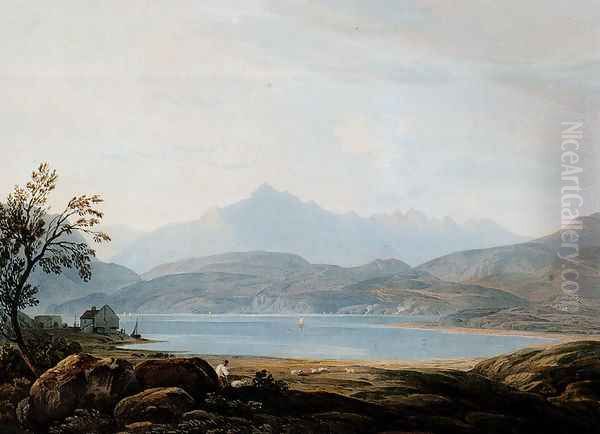
He favoured broad, transparent washes of colour, applied with confidence and clarity. Unlike some contemporaries who used bodycolour (opaque watercolour) for highlights, Varley generally preferred the luminosity achieved through pure, transparent layers, allowing the white of the paper to shine through and create effects of light. His compositions are typically well-structured, often employing established formulas but imbued with a sense of calm grandeur and atmospheric depth. He mastered the depiction of light and shadow, using tonal contrasts to define form and create mood.
Varley developed a systematic approach to landscape composition, often based on idealized principles rather than strict topographical accuracy. He sought to capture the essential character and emotional resonance of a scene. His preferred subjects included mountains, lakes, rivers, castles, and classical ruins, frequently populated with small figures that add scale and a touch of pastoral life. His Welsh landscapes, in particular, are celebrated for their majestic yet tranquil beauty, capturing the unique light and rugged forms of areas like Snowdonia.
His technique involved laying down successive washes, building up tone and colour gradually. He often worked with a limited palette, achieving harmony through subtle variations in hue and value. While his earlier work might show tighter handling, his later style became broader and more atmospheric, reflecting the general trend towards greater expressiveness in British landscape painting during the Romantic era. He aimed for dignity and repose in his art, creating images that were both visually pleasing and emotionally evocative.
Representative Works
Throughout his prolific career, John Varley produced a vast number of watercolours. Several works stand out as representative of his style and achievements. His early View of Peterborough Cathedral, exhibited at the Royal Academy, likely stemmed from his sketching tour with Barrow and demonstrated his early mastery of architectural subjects within a landscape setting. This work garnered positive attention and helped establish his reputation.
Varley's numerous depictions of Welsh scenery are perhaps his most characteristic and celebrated works. Titles such as Snowdon, Cader Idris, and Harlech Castle appear frequently in his oeuvre. Harlech Castle, for instance, often depicted under dramatic or serene light conditions, allowed Varley to combine his interest in historic architecture with the rugged grandeur of the Welsh landscape. These works showcase his ability to create balanced compositions and evoke a powerful sense of place, often imbued with a Claudian sense of idealized beauty.
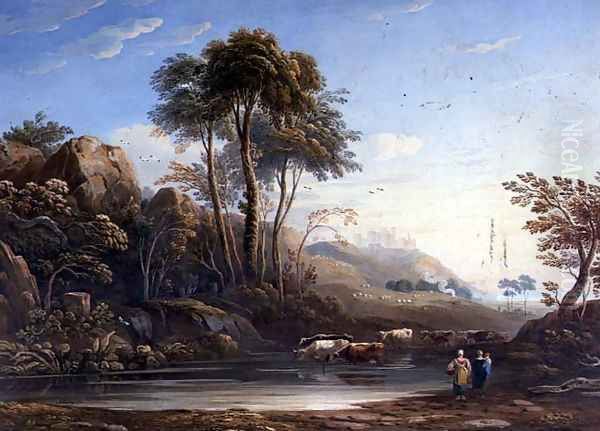
Works like Figures on a Path by the Thames demonstrate his skill in depicting gentler, more pastoral English scenery, capturing the tranquil flow of the river and the quality of light on water and foliage. Even in these quieter scenes, his characteristic breadth of handling and compositional clarity are evident. He often repeated compositions with variations, refining his ideas and catering to market demand.
His Treatise on the Principles of Landscape Design, published with aquatint illustrations, served both as an instructional manual and a showcase of his compositional ideas. The plates within demonstrate his formulas for constructing idealized landscapes, breaking down complex scenes into manageable elements of foreground, middle ground, and distance, often framed by trees in the manner of Claude Lorrain. These published works further disseminated his artistic principles.
An Influential Teacher
John Varley's significance extends far beyond his own artistic output; he was arguably the most sought-after and influential drawing master of his time in London. His studio became a hub for aspiring artists, both professional and amateur. Varley possessed a knack for teaching, combining practical instruction with theoretical principles and infectious enthusiasm. He charged substantial fees but attracted a remarkable roster of pupils who would go on to achieve great fame.
Among his most notable students were David Cox, known for his vigorous and atmospheric landscapes; William Henry Hunt, celebrated for his detailed still lifes and rustic figures; Peter De Wint, famed for his broad, moist handling of watercolour; John Linnell, a versatile painter and engraver who became a close friend of William Blake; and William Mulready, who achieved success as a genre painter. Other significant pupils included Copley Fielding, later President of the SPWC, Francis Oliver Finch, known for his poetic landscapes, George Robert Lewis, and William Turner of Oxford (distinct from J.M.W. Turner), who specialized in tranquil landscapes.
Varley's teaching method emphasized understanding the underlying principles of composition, perspective, and light and shade. He encouraged drawing from nature (plein air sketching), particularly during sketching tours he undertook with students, but also taught how to compose idealized landscapes in the studio based on established formulas and memory. He provided students with principles and structures they could adapt to their own developing styles. His systematic approach offered a clear pathway for learning, which proved highly effective.
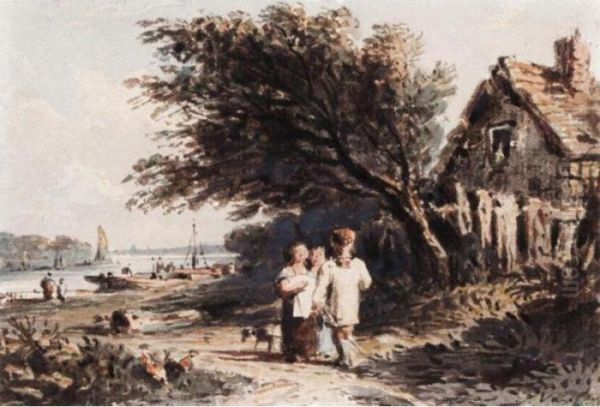
He famously grouped some of his most promising younger students, including Samuel Palmer, George Richmond, and Edward Calvert, who later formed the core of the visionary group known as "The Ancients." Varley's influence on Palmer, in particular, was profound, encouraging his mystical interpretations of the English landscape, even if Palmer's intense, detailed style eventually diverged significantly from Varley's broader manner. Varley's role as a mentor fostered a generation of diverse talent within British art.
Writings and Inventions
Beyond his painting and teaching, John Varley was intellectually curious and engaged in writing and invention. His pedagogical impulse led him to publish several instructional books that codified his teaching methods and artistic philosophy. A Treatise on the Principles of Perspective provided clear guidance on a fundamental aspect of drawing, essential for both architectural and landscape representation. His Principles of Landscape Design, illustrated with examples, offered formulas and advice for composing effective landscape pictures.
These publications made his ideas accessible to a wider audience beyond his direct pupils and contributed to the standardization of landscape drawing techniques during the period. They reflect his methodical mind and his desire to rationalize the process of artistic creation, breaking it down into understandable components. While some might criticize these formulas as potentially stifling creativity, they provided a valuable framework for many aspiring artists.
Varley also possessed an inventive streak, though not always successfully. He patented a "graphic telescope" in 1811, an optical device intended to aid in drawing landscapes accurately by projecting the scene onto paper. While perhaps not widely adopted, it demonstrates his interest in the intersection of art and optics. More eccentrically, he experimented with mechanics, designing a six-wheeled carriage intended to be safer and more stable, and reportedly spent considerable time and money attempting to create a perpetual motion machine – a common obsession among inventors of the era, though ultimately futile.
His most unusual publication was undoubtedly A Treatise on Zodiacal Physiognomy, published in 1828. This work explored his theories on the connection between facial features and astrological signs, illustrated with engravings based on drawings by William Blake and others. It reveals Varley's deep and lifelong commitment to astrology, an interest that set him apart from many of his more conventional contemporaries.
Friendship with William Blake
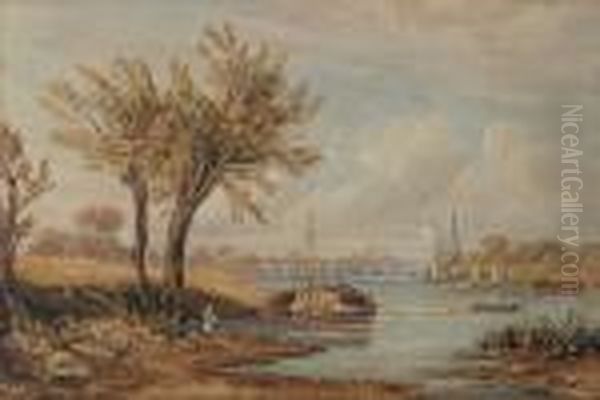
One of the most intriguing aspects of John Varley's life was his close friendship and professional association with the visionary poet and artist William Blake. Varley met Blake around 1818, likely through their mutual acquaintance John Linnell. Despite their different temperaments – Varley being generally pragmatic and sociable, Blake mystical and intense – they formed a strong bond. Varley became a significant source of support and encouragement for the older, often impoverished Blake during his later years.
Varley was fascinated by Blake's accounts of his spiritual visions. Rather than dismissing them, Varley encouraged Blake to draw the historical and imaginary figures who appeared to him. This collaboration resulted in the famous series of drawings known as the "Visionary Heads," produced mostly between 1819 and 1825. During late-night sessions at Varley's house, Blake would sketch portraits of figures like William Wallace, Edward I, King Saul, and more fantastical beings like "The Man Who Built the Pyramids" and the notorious "Ghost of a Flea," claiming they appeared before his mind's eye.
Varley acted as both witness and scribe, sometimes prompting Blake and documenting the circumstances of the visions. Several of these drawings, including studies for "The Ghost of a Flea," were intended to illustrate Varley's Treatise on Zodiacal Physiognomy. The relationship highlights Varley's openness to the unconventional and his genuine admiration for Blake's unique genius. While Varley himself was not a visionary artist in the same vein as Blake, his patronage and friendship provided crucial validation and stimulus for Blake's extraordinary imagination during this period.
The collaboration on the Visionary Heads remains a unique episode in British art history, showcasing the intersection of Varley's astrological interests and Blake's spiritual insights. It underscores Varley's multifaceted personality, capable of embracing both the rational principles of perspective and the seemingly irrational world of psychic visions.
Astrology and Eccentricities
John Varley's deep involvement with astrology was more than a casual hobby; it was a guiding principle in his life and work. He cast horoscopes for himself, his family, and his friends, including William Blake and John Linnell. His belief in astrology was sincere and profound, influencing his decisions and interpretations of events. His publication, A Treatise on Zodiacal Physiognomy, was a serious attempt to systematize his theories linking astrology to human appearance and character.

His astrological beliefs often led to eccentric behaviour and predictions. The most famous anecdote concerns his prediction of a house fire. According to accounts, he calculated the exact time his house would catch fire and calmly documented it. When the fire indeed broke out as predicted (though causing minor damage), it supposedly reinforced his faith in the predictive power of astrology. Such stories contributed to his reputation as an amiable but decidedly odd character.
Varley's life was marked by a certain lack of financial prudence, possibly linked to his optimistic astrological outlook or simply a generous nature. Despite earning considerable sums from teaching and selling his popular watercolours, he was frequently in debt. His generosity towards those in need was well-known, but it often left him financially strained. He experienced periods of significant hardship and even spent time in a debtors' prison. His attempts at invention, like the perpetual motion machine, likely also consumed resources.
These eccentricities, combined with his genuine artistic talent and influential teaching, created a memorable persona. He was described by contemporaries as jovial, talkative, and highly superstitious. His belief in astrology, while perhaps viewed skeptically by some, was an integral part of his worldview and added a layer of mystique to his character. He navigated the rational world of perspective and composition alongside the esoteric realm of planetary influence.
Later Life and Legacy
Despite his artistic success and reputation as a teacher, John Varley faced ongoing financial difficulties throughout much of his life. His large family (he married twice and had numerous children) and perhaps his own mismanagement of funds contributed to these struggles. He continued to paint prolifically and teach, relying on his art to support his household. His work remained popular, and he continued exhibiting regularly at the SPWC.
In his later years, Varley's health began to decline. He suffered from ailments, possibly exacerbated by stress and financial worries. He passed away on November 17, 1842, at the age of 64, reportedly from inflammation of the kidneys, while staying at the home of a friend. It is said that his final illness was aggravated by exposure after being caught in inclement weather. His death marked the end of a significant era in British watercolour painting.
John Varley's legacy is substantial and multifaceted. As a painter, he produced a vast body of work that exemplifies the classical grace and atmospheric beauty achievable in watercolour. His landscapes, particularly those of Wales, remain highly regarded for their compositional strength and serene mood. His works are held in major public collections, including the Tate Britain, the Victoria and Albert Museum, the British Museum, and numerous regional galleries across the UK and internationally.
As a teacher, his influence was immense. He nurtured a generation of artists who shaped the course of British landscape and watercolour painting in the 19th century. His pupils, including David Cox, Peter De Wint, William Henry Hunt, John Linnell, and Samuel Palmer, represent a diverse range of styles, yet all benefited from his foundational instruction and encouragement. His systematic approach and published manuals helped to codify and disseminate techniques for landscape representation.
Furthermore, his role in founding and supporting the Society of Painters in Water-Colours was crucial in elevating the status of the medium. His friendship with William Blake adds another layer of significance, linking him to one of Britain's most original artistic minds. Though marked by eccentricities and financial struggles, John Varley's dedication to his art, his influential teaching, and his central role in the watercolour movement secure his position as a key figure in British art history. He remains remembered as a master technician, an inspiring mentor, and a truly unique personality.